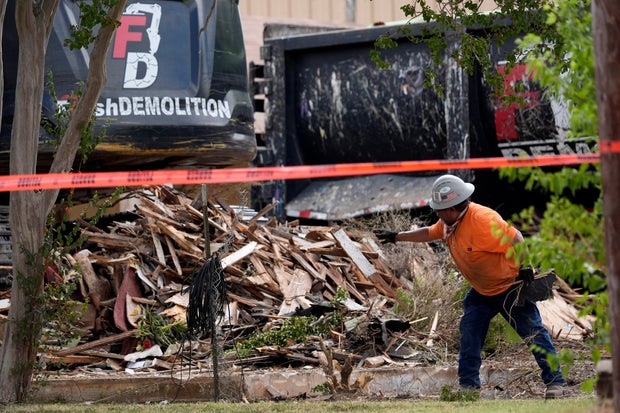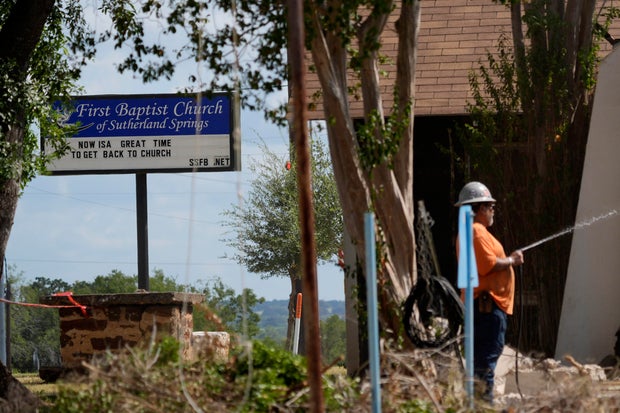CBS News
Demolition begins at Sunderland Springs church site of 2017 mass shooting

Demolition began Monday at the Texas church that was the site of a mass shooting that killed more than two dozen worshippers in 2017 even after some families sought to preserve the scene of the deadliest church shooting in U.S. history.
Eric Gay / AP
Last month, state District Court Judge Russell Wilson cleared the way for the First Baptist Church of Sutherland Springs to tear down the sanctuary where the attack happened. Until now, it had been kept as a memorial that included the names of the people killed. Wilson’s ruling came after some families in the community of fewer than 1,000 people filed a lawsuit hoping for a new vote on the building’s fate. Church members voted in 2021 to tear it down.
A new church was completed for the congregation about a year and a half after the shooting.
John Riley, an 86-year-old member of the church, watched with sadness and disappointment as the long arm of a yellow excavator swung a heavy claw into the building over and over on Monday.
“The devil got his way,” Riley said, “I would not be the man I am without that church.”
Eric Gay / AP
He said he would pray for God to “punish the ones” who put the demolition in motion.
“That was God’s house, not their house,” Riley said.
For many in the community, the sanctuary was a place of solace.
Terrie Smith, president of the Sutherland Springs Community Association, visited often over the years, calling it a place where “you feel the comfort of everybody that was lost there.” Among those killed in the shooting were a woman who was like a daughter to Smith — Joann Ward — and Ward’s two daughters, ages 7 and 5.
Smith watched Monday as the memorial sanctuary was torn down.
“I am sad, angry, hurt,” she said.
Eric Gay / AP
In early July, a Texas judge granted a temporary restraining order sought by some families. But another judge later denied a request to extend that order, setting in motion the demolition. In court filings, attorneys for the church called the structure a “constant and very painful reminder.”
Attorneys for the church argued that it was within its rights to demolish the memorial while the attorney for the families who filed the lawsuit said they were just hoping to get a new vote.
In the lawsuit, the plaintiffs alleged that some church members were wrongfully removed from the church roster before the vote was taken. In a court filing, the church denied the allegations in the lawsuit.
A woman who answered the phone at the church said Monday that she had no comment then hung up.
Eric Gay / AP
The man who opened fire in the church, Devin Patrick Kelley, died of a self-inflicted gunshot wound after he was chased by bystanders and crashed his car. Investigators have said the shooting appeared to stem from a domestic dispute involving Kelley and his mother-in-law, who sometimes attended services at the church but was not present on the day of the shooting.
Communities across the U.S. have grappled with what should happen to the sites of mass shootings. Last month, demolition began on the three-story building where 17 people died in the 2018 mass shooting at Marjory Stoneman Douglas High School in Parkland, Florida. After the 2012 shooting at Sandy Hook Elementary School in Connecticut, it was torn down and replaced.
Tops Friendly Markets in Buffalo, New York, and the Emanuel African Methodist Episcopal Church in Charleston, South Carolina, where racist mass shootings happened, both reopened. In Colorado, Columbine High School still stands, though its library, where most of the victims were killed, was replaced.
In Texas, officials closed Robb Elementary in Uvalde after the 2022 shooting there and plan to demolish the school.
CBS News
Gazan chefs cook up hope and humanity for online audience

Renad Atallah is an unlikely internet sensation: a 10-year-old chef, with a repertoire of simple recipes, cooking in war-torn Gaza. She has nearly a million followers on Instagram, who’ve witnessed her delight as she unpacks parcels of food aid.
CBS News
We interviewed Renad via satellite, though we were just 50 miles away, in Tel Aviv. [Israel doesn’t allow outside journalists into Gaza, except on brief trips with the country’s military.]
“There are a lot of dishes I’d like to cook, but the ingredients aren’t available in the market,” Renad told us. “Milk used to be easy to buy, but now it’s become very expensive.”
I asked, “How does it feel when so many people like your internet videos?”
“All the comments were positive,” she said. “When I’m feeling tired or sad and I want something to cheer me up, I read the comments.”
We sent a local camera crew to Renad’s home as she made Ful, a traditional Middle Eastern bean stew. Her older sister Noorhan says they never expected the videos to go viral. “Amazing food,” Noorhan said, who added that her sibling made her “very surprised!”
After more than a year of war, the Gaza Strip lies in ruins. Nearly everyone has been displaced from their homes. The United Nations says close to two million people are experiencing critical levels of hunger.
Hamada Shaqoura is another chef showing the outside world how Gazans are getting by, relying on food from aid packages, and cooking with a single gas burner in a tent.
Shaqoura also volunteers with the charity Watermelon Relief, which makes sweet treats for Gaza’s children.
In his videos online, Shaqoura always appears very serious. Asked why, he replied, “The situation does not call for smiling. What you see on screen will never show you how hard life is here.”
Before dawn one recent morning in Israel, we watched the UN’s World Food Program load nearly two dozen trucks with flour, headed across the border. The problem is not a lack of food; the problem is getting the food into the Gaza Strip, and into the hands of those who desperately need it.
The UN has repeatedly accused Israel of obstructing aid deliveries to Gaza. Israel’s government denies that, and claims that Hamas is hijacking aid.
“For all the actors that are on the ground, let the humanitarians do their work,” said Antoine Renard, the World Food Program’s director in the Palestinian territories.
I asked, “Some people might see these two chefs and think, well, they’re cooking, they have food.”
“They have food, but they don’t have the right food; they’re trying to accommodate with anything that they can find,” Renard said.
Even in our darkest hour, food can bring comfort. But for many in Gaza, there’s only the anxiety of not knowing where they’ll find their next meal.
For more info:
Story produced by Mikaela Bufano. Editor: Carol Ross.
See also:
“Sunday Morning” 2024 “Food Issue” recipe index
Delicious menu suggestions from top chefs, cookbook authors, food writers, restaurateurs, and the editors of Food & Wine magazine.
CBS News
A study to devise nutritional guidance just for you

It’s been said the best meals come from the heart, not from a recipe book. But at this USDA kitchen, there’s no pinch of this, dash of that, no dollops or smidgens of anything. Here, nutritionists in white coats painstakingly measure every single ingredient, down to the tenth of a gram.
Sheryn Stover is expected to eat every crumb of her pizza; any tiny morsels she does miss go back to the kitchen, where they’re scrutinized like evidence of some dietary crime.
Stover (or participant #8180, as she’s known) is one of some 10,000 volunteers enrolled in a $170 million nutrition study run by the National Institutes of Health. “At 78, not many people get to do studies that are going to affect a great amount of people, and I thought this was a great opportunity to do that,” she said.
CBS News
It’s called the Nutrition for Precision Health Study. “When I tell people about the study, the reaction usually is, ‘Oh, that’s so cool, can I do it?'” said coordinator Holly Nicastro.
She explained just what “precise” precisely means: “Precision nutrition means tailoring nutrition or dietary guidance to the individual.”
The government has long offered guidelines to help us eat better. In the 1940s we had the “Basic 7.” In the ’50s, the “Basic 4.” We’ve had the “Food Wheel,” the “Food Pyramid,” and currently, “My Plate.”
CBS News
They’re all well-intentioned, except they’re all based on averages – what works best for most people, most of the time. But according to Nicastro, there is no one best way to eat. “We know from virtually every nutrition study ever conducted, we have inner individual variability,” she said. “That means we have some people that are going to respond, and some people that aren’t. There’s no one-size-fits-all.”
The study’s participants, like Stover, are all being drawn from another NIH study program called All Of Us, a massive undertaking to create a database of at least a million people who are volunteering everything from their electronic health records to their DNA. It was from that All of Us research that Stover discovered she has the gene that makes some foods taste bitter, which could explain why she ate more of one kind of food than another.
Professor Sai Das, who oversees the study at Tufts University, says the goal of precision nutrition is to drill down even deeper into those individual differences. “We’re moving away from just saying everybody go do this, to being able to say, ‘Okay, if you have X, Y and Z characteristics, then you’re more likely to respond to a diet, and somebody else that has A, B and C characteristics will be responding to the diet differently,'” Das said.
It’s a big commitment for Stover, who is one of 150 people being paid to live at a handful of test sites around the country for six weeks – two weeks at a time. It’s so precise she can’t even go for a walk without a dietary chaperone. “Well, you could stop and buy candy … God forbid, you can’t do that!” she laughed.
While she’s here, everything from her resting metabolic rate, her body fat percentage, her bone mineral content, even the microbes in her gut (digested by a machine that essentially is a smart toilet paper reading device) are being analyzed for how hers may differ from someone else’s.
Nicastro said, “We really think that what’s going on in your poop is going to tell us a lot of information about your health and how you respond to food.”
CBS News
Stover says she doesn’t mind, except for the odd sounds the machine makes. While she is a live-in participant, thousands of others are participating from their homes, where electronic wearables track all kinds of health data, including special glasses that record everything they eat, activated when someone starts chewing. Artificial intelligence can then be used to determine not only which foods the person is eating, but how many calories are consumed.
This study is expected to be wrapped up by 2027, and because of it, we may indeed know not only to eat more fruits and vegetables, but what combination of foods is really best for us. The question that even Holly Nicastro can’t answer is, will we listen? “You can lead a horse to water; you can’t make them drink,” she said. “We can tailor the interventions all day. But one hypothesis I have is that if the guidance is tailored to the individual, it’s going to make that individual more likely to follow it, because this is for me, this was designed for me.”
For more info:
Story produced by Mark Hudspeth. Editor: Ed Givnish.
“Sunday Morning” 2024 “Food Issue” recipe index
Delicious menu suggestions from top chefs, cookbook authors, food writers, restaurateurs, and the editors of Food & Wine magazine.
CBS News
A new generation of shopping cart, with GPS and AI

Watch CBS News
Be the first to know
Get browser notifications for breaking news, live events, and exclusive reporting.

















